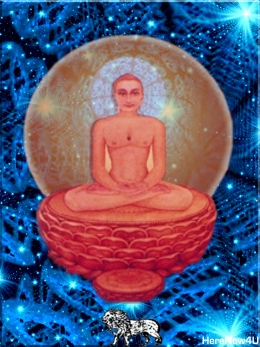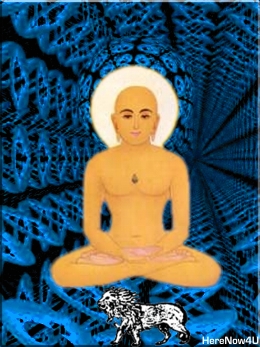
Jainism is one of the world's oldest religions. Much of its early history is not known, or has come down to us in a form in which historical fact is difficult to distinguish from miraculous stories. However we do know that this ancient religion was passed on to us through the high spiritual genius of one of the greatest religious teachers of all time, Mahavira.
We must be clear, from the start, that Mahavira was not the founder of Jainism. What he did was to bring together in a systematic form the beliefs and philosophy of his predecessors, preach them widely throughout his home country, and lay the foundations of an organized Jain 'church' with monks and nuns and lay people following his teachings. The social order which he created has endured to the present day.
Mahavira was not some imaginary being. He was a real man, and we know, with reasonable certainty, that his life on earth ended just over 2500 years ago, in 527 B.C.
We know details of his life.
He was born in 599 B.C. into a family of the ksatriya [knightly caste]. His father, Siddhartha, was a prince or lord, and his mother, Trisala, also came from a noble family. His birthplace is believed to have been near the modern city of Patna, in Bihar in north-eastern India. Although generally referred to as Mahavira (which means 'great hero'), his original name was Vardhamana. Until his late twenties he doubtless led a life not very different from that of any other young man in his level of society.
Both his parents were followers of the religious teachings of Parsva, the 'fourfold teaching', chaturyama dharma, abstention from violence, theft, untruth and acquisitiveness. We should nowadays call them Jains. Parsva, who had lived some 250 years before Mahavira, is recognized as the twenty- third Tirthankara or prophet of Jainism.
It was shortly after his parents' death that Vardhamana, or Mahavira, decided at the age of thirty to renounce a worldly life. He gave up all his possessions, even his clothes, and lived for the next twelve years a life of great hardship, training himself to endure the pains and discomforts of the body until he became indifferent to them.
The wandering ascetic, seeking knowledge alone in the wilder places, or in company with fellow seekers for truth, was (and still is) an accepted figure on the edge of Indian society.
The sixth century B.C. was an era of intellectual ferment, an exciting period for a young man of inquiring spirit, when various groups were searching beyond the bounds of the rather rigid religious orthodoxy of the time. The best-known individual, at least in historical perspective, was the Buddha, a near contemporary of Mahavira.
Some of the earlier Western scholars who encountered Jainism did not distinguish it from Buddhism (for there are some similarities, as well as very marked differences) and even confused the persons of Mahavira and the Buddha. Mahavira persevered with this austere life style, marked by long spells of fasting and other penances, and by deep meditation. At last, during one period of meditation by the side of a river, he came to a comprehension of the whole nature and meaning of the universe.
This total knowledge, omniscience, Kevala Jnana; is very important to Jainism. Most of us have had the experience, at some time, of puzzling over something we do not quite understand, when, suddenly, almost as though a cloud clears, we get a flash of understanding and we see the solution to our problem. Can we imagine this flash of understanding spreading out, clearing the clouds over not just our small problem but all the problems of the universe, giving us an understanding of the whole nature and workings and meaning of the universe?
This is what happened to Mahavira.
And it can happen, and has happened, to other people as well.
This total knowledge does not come easily: for Mahavira, as we have seen, it was the result of years of austerity and meditation. This was the fourth of the five great events of Mahavira's life which are celebrated by Jains today: his conception, birth, renunciation, and now enlightenment. The fifth great event, nirvana or moksa came thirty years later.
During these thirty years Mahavira, strengthened by his knowledge, spread his message among the people. He spoke in the language of the region, Ardhamagadhi, not in the classical Sanskrit of the scholars, and the oldest Jain scriptures are preserved in that language. Some people, men and women, were inspired to give up all possessions and become monks and nuns. Others were unable to go that far but followed Mahavira's teachings without giving up their homes and families and work.
Mahavira taught a scientific explanation of the nature and meaning of life and a guide as to how we should behave to draw this real nature and meaning into our own life. We must start with three things.
- we must have RIGHT FAITH, we must believe in truth.
- we must have the RIGHT KNOWLEDGE, we must study to understand what life is all about.
- we must follow RIGHT CONDUCT, the conduct which our faith and knowledge show us to be correct.
These are the 'three jewels', Ratnatraya.of Jainism.
RIGHT FAITH is perhaps the hardest of all. Nobody can tell us what we can believe, but we can look at the message of Mahavira and believe that he really did know what he was talking about and that his message makes sense.
Mahavira's message contains the basis of RIGHT KNOWLEDGE.
Life is a puzzle.
Where did we come from before birth? Where do we go after death? Nobody's life is completely and totally happy, but why do some people have lives of great misery and others have much joy?
Mahavira teaches us that this is not the result of the whims of some distant god.
No, each one of us is what we have made ourselves by our actions in this life and in previous lives.
Every individual (and not only humans, but animals and plants) is basically a pure spirit or soul (jiva is the Jain word for it) which is capable of complete knowledge and complete freedom. But by our actions and thoughts we have, as it were, covered this pure spirit with the gross material of karma which obscures our knowledge and limits our freedom and ties us down to one life after another.
Although we may have a lot of happiness in life we also, all of us, have a great deal of unhappiness. We want to know the way in which we can get rid of the restrictions of karma and gain the state of complete knowledge and glorious freedom which is known as moksa or nirvana. Although this may be a very long, very slow process for most of us, over countless lives, Mahavira teaches us how to make a start in freeing ourselves from the restrictions and miseries of karma.
So we come to RIGHT CONDUCT. Strength of passions is the worst thing, passions of violence and desire and possession. The most important principle which runs through the whole of Mahavira's attitude of life is ahimsa.
This is usually translated as 'non-violence', but it goes beyond that and really means the greatest possible kindness to all living things.
This is the first and fundamental rule which we should try to follow, to get rid of violence in all our actions and even in our thoughts.
Yes, in our thoughts as well, for violent thoughts can be potentially as harmful as violent deeds.
Mahavira's teachings, if faithfully followed, have two results.
Firstly, they produce a better society for every creature to live in, and secondly, they enable the individual to improve his or her own inner feelings and character.
So, following on from ahimsa, we are taught to be truthful and honest, to create both individuals and a society in which lies and theft, and general insecurity, are absent. Lies and theft are the result of our passions and possessiveness. True peace and harmony in society and in the individual are possible only if we can restrain our passions and desires.
So Mahavira tells us to reduce our longing for the things of the world, for material possessions and for sexual activities. We can never have real peace of spirit so long as we are constantly seeking more and more possessions and pleasures.
These then are the five rules of conduct which Mahavira taught, non-violence, truthfulness, no stealing, non-acquisition and control of sexual desires.
It is a hard program and not everybody can follow it all at once.

So Mahavira set up a society in which some people, monks and nuns, try to follow his program as far as is humanly possible.
Others, ordinary lay people, men and women, do not give up their homes and jobs and families, but they try as far as possible in the circumstances of daily life to follow the five rules of conduct.
While the monk or nun can take precautions to avoid harm even to the tiniest living creature, the rule of non-violence must mean something less for ordinary people caught up in the ordinary business of our lives.
A monk or nun can give up all possessions and seek no more: for most of us non-acquisition must mean trying to reduce our craving for possessions and the pleasures of the world.
Monks and nuns can go very much further than married men and women in subduing their attachment to sex.
Mahavira taught his message for thirty years until his life on earth ended and he passed on to that state of complete freedom and bliss and peace which we call moksa.
For most of us moksa is a very long way away. But he taught us how we can approach it ourselves by rules which lead to inner peace and harmony inside ourselves and outward peace and harmony in human society.
He taught more than that, a democratic organization in the society which he set up, with all men and women playing their part and with no barriers of class or caste.
He also taught tolerance and an appreciation that things can be seen from more points of view than one.
Above all he taught that we ourselves produce our own fate by our own actions and emotions: we should not look outside for some god to praise or blame or ask for favours.
When we honour Mahavira we do not ask him for present help, but we meditate on his example and teachings and seek to draw the real meaning of these into our own life and spirit.
This is the essence of Mahavira's teachings.
Jainism is one of the world's oldest religions: the modern Jain may well see it as scientific, practical and fitted for the modern world.
